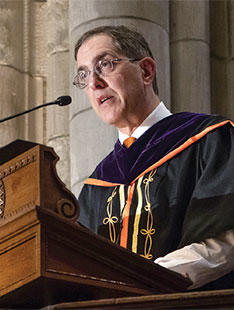The Library: Building on Strengths in a Dynamic Environment

Anne Jarvis became the University Librarian in 2016. Her thoughtful and innovative leadership of our library system helps to enable the teaching and research of scholars at Princeton and around the globe. I have invited her to share a few thoughts on the evolution of the library. — C.L.E.
Princeton University Library (PUL) has been central to the University’s academic life for so long that its future influence could easily be taken for granted. The dizzying speed of technological and cultural change in education and research, however, now requires all great academic libraries to be innovative, dynamic, and responsive to the rapidly evolving expectations of their users. Traditionally, research libraries supported education and the creation of knowledge by acquiring a wide range of physical books, manuscripts, and archive material. PUL continues to build a broad and deep collection, but it also now offers a wide variety of services and tools that support innovative means of accessing and curating information, irrespective of format. In what follows I hope to give a flavor of exactly how the Library is working to deliver such change whilst retaining the traditional qualities that served to establish its world-class reputation.
Last spring marked a significant milestone for PUL, as we celebrated the completion of the Harvey S. Firestone Memorial Library’s 10-year renovation project. Anyone who studied in Firestone prior to the renovation will find it magically and marvelously transformed. Collection location is more intuitive, as is navigation. The Trustee Reading Room looks better than ever, but it now sits alongside modern spaces designed to support collaboration and communication: the Center for Digital Humanities (CDH), the Data and Statistical Services Unit, Imaging and Conservation labs, teaching spaces, group study rooms, specialized reading rooms, and the Tiger Tea Room.
These changes reflect and support the evolving research and teaching environment of Princeton and represent the Library’s embrace of a dynamic new environment that allows us to build on our existing strengths. Thanks to the generous support of numerous alumni collectors over the centuries, we have a treasure trove of resources — be they books, manuscripts, or archives — and technological innovation allows our students and faculty to discover and engage with them in fresh ways. Advancements in digital technology in particular have triggered an information revolution comparable to the arrival of the printing press. PUL is facilitating unprecedented access to our collections through digitization, with over 160,000 items and 5 million images from our collections now available online. In the past year alone, highlights of the PUL digital studio’s work included a 17th-century German Amuletic Scroll, the original cover art for The Great Gatsby, and an album of photographs of the construction of the Eiffel Tower taken by Gustav Eiffel’s son-in-law, all now online. Far from undermining the importance of our collections, the digital world has presented an opportunity for libraries to open up collections to new audiences as well as to collate scattered rare books and manuscripts, permitting new methods of study and analysis.
In addition to digitization, the Library serves as both steward and innovator in this data-driven age. In partnership with the CDH, PUL’s unique collections are being transformed into scholarly datasets and online archives. Faculty collaborations such as the digital Shakespeare and Company Project bring library resources to new audiences. Users around the world can browse through Sylvia Beach’s famous Parisian bookstore and make their own discoveries about the Lost Generation. Furthermore, the Library maintains vast datasets and tools that we teach our students how to use, so that they can analyze disparate statistical data and discover connections to previously unanswerable questions. Examples of current projects include the impact of state regulatory malpractice law differences on choice and cost of medical procedures, vaping prevalence by presence of social capital, and opportunity zones and household debt correlation using detailed mortgage records.
PUL has always collected the printed output of our faculty and students, but the recently established Princeton Research Data Service (PRDS) supports the needs of researchers to manage, store, curate, and find digital research data. Datasets that have recently been deposited with the Library include astrophysics data modelling interstellar dust, genomics microscopy data investigating helical cell shape in bacteria, and a geosciences dataset underlying research on properties of sound velocity in shock-compressed silica. As a joint initiative between PUL, the Office of the Dean for Research, and the Office of the Vice President of Information Technology, PRDS is a natural progression for library services as we expand our collaboration with campus partners.
These are just some of the highlights from the Library’s ongoing efforts to provide the right service, resource, and knowledge to our faculty and students. A key element of my work is maintaining strong relationships with University stakeholders to ensure that library services are integrated with the University’s agenda for research, teaching, and learning. While we cannot always predict what is coming ahead, we remain in constant dialogue with faculty and students as we seek to anticipate changing needs and expectations. There could scarcely be a more exciting and rewarding time to lead PUL, and my colleagues and I look forward to the challenges ahead.











No responses yet